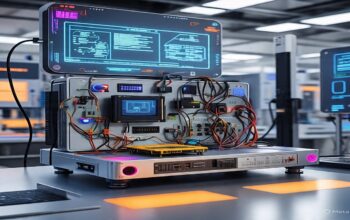Covered Contents
ToggleWhat is the Majorana 1 Chip?
The Majorana 1 chip has been unveiled by Microsoft. This is a fresh quantum computer chip. It calculates and stores information using special particles known as Majorana fermions. This design tries to resolve some of the common problems facing quantum computing. These include a lack of stability and an inability to be scaled up.
How Does the Majorana 1 Chip Work?
Traditional quantum chips use trapped ion qubits or superconducting loops that are error-prone and sensitive. Qubits are subjected to electromagnetic noise and thermal fluctuations. The Majorana 1 chip uses Majorana fermions, quasiparticles that exist only under specific conditions. They exist in pairs, and the information is stored in their shared quantum state. Even if one particle is faulty, the information is not disturbed, reducing errors.
Why Is It a Breakthrough?
Existing quantum computers are huge and contain special cooling systems, noise reduction, and error correction. Therefore, they are not useful for most applications. Microsoft’s Majorana 1 chip uses topological qubits, which are robust in themselves. They point out that these qubits will minimize errors by as much as 90%. If successful, this could lead to compact, reliable quantum computers capable of tackling complex tasks
Majorana particles are unique particle types that are the opposite of one another. They were discovered in studies in 2018 after being proposed by experts in 1937.
Information can be stored in qubits, which are pairs of Majorana particles utilized in quantum computing. Because of the manner these qubits are stored, their environment is less likely to disturb them. They are therefore less prone to mistakes and more stable than standard qubits. Quantum computers that are more dependable and efficient may result from this stability.
Why This Might Be a Game-Changer
Modern quantum computers employ delicate qubits (such as Google’s or IBM’s) that readily lose information. They need enormous cooling systems and additional qubits simply to correct errors. Majorana qubits, theoretically, remain stable longer. If Microsoft can demonstrate that their design succeeds, it would mean:
– Less error, so less error correction.
– Smaller machines that don’t need extreme cooling.
– Scaling up to thousands of qubits without uproar
How Is Majorana 1 Chip Different from Traditional Quantum Chips?
Feature | Traditional Quantum Chips | Majorana 1 Chip |
Error Resistance | Require constant error correction | Naturally resistant to errors |
Size | Larger and less dense | Smaller and more compact |
Scalability | Difficult to scale | Easier to add more qubits |
What Challenges Do Experts Highlight?
– Unproven Reproducibility: In 2021, Microsoft retracted a Nature paper on Majorana fermions after other labs failed to replicate results. Skeptics worry history could repeat.
– No Public Data: Microsoft has not released detailed performance metrics (e.g., error rates, qubit count) or allowed independent testing.
– Engineering Hurdles: Maintaining conditions for Majorana fermions (near-zero temperatures, precise material setups) remains technically challenging.
Future Impact of the Majorana 1 Chip
If successful, the chip could speed up quantum computing in areas like drug discovery and cryptography. Stable qubits may also allow quantum systems to work better with classical computers.
Will It Make Things More Stable and Scalable?
Microsoft says yes. The “noise” that plagues traditional systems is avoided by topological qubits. More qubits could be added in the future, enabling quantum computers to grow in power, according to enhanced scalability. Because there are fewer errors, fewer duplicate qubits are needed to fix them, which could lead to smaller, more scalable devices. Until experiments show otherwise, this is still theoretical.
What Do Physicists Say?
Reactions are divided:
Benefactors: Mark it as “promising” for the solutions of quantum error issues (Dr. Chetan Nayak, Microsoft scientist since 2005).
Critics: Need proof. “Without data, it is just hype,” says Dr. Sergey Frolov, quantum condensed matter theorist. Some note even if Majorana qubits work, scaling to thousands of them is unbiased.
Is the Quantum Future Here?
Maybe, but there are still obstacles to get beyond. Although topological qubits are very appealing in theory, engineers have not yet solved the issues that would allow them to be used. Other strategies (such as photonic chips and IBM superconducting qubits) are more suited for the manufacturing floor. Reaching a Majorana 1 goal depends on Microsoft publishing results that can be replicated and other people doing the same. However, the technology is still too young. Microsoft’s strategy is only one of many being investigated. What its true impact is will become clear with time and more research.
Conclusion Paragraph:
– The Majorana 1 chip employs exotic particles to form stable qubits.
– Assertions of fewer errors and scalability are unsubstantiated but have the potential to revolutionize computing.
-Transparency and peer review will decide whether this is a breakthrough or a misstep.
This discovery, if it holds, may mean that quantum computers become quicker and more dependable, unleashing new horizons in science and technology. Microsoft’s declaration raises hope, but with every quantum leap comes the caveat of details. The world waits for proof.



One thought on “Microsoft’s Majorana 1 Chip: A Quantum Leap or Overhyped Breakthrough?”